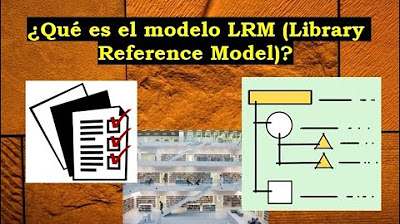Mengetahui Sistem Klasifikasi Perpustakaan | oleh : Lucky Audrylya Mahatan
Summary
TLDRIn this video, the presenter introduces the concept of library classification systems. They explain that classification involves grouping library materials based on subjects or other attributes to aid information retrieval. The video covers three primary types of classification systems: artificial, utility, and fundamental. The fundamental system includes the Dewey Decimal Classification (DDC), Universal Decimal Classification (UDC), and Library of Congress Classification (LCC). The presenter provides insights into the history and development of these systems, emphasizing their significance in facilitating the organization and accessibility of library materials.
Takeaways
- 😀 Classification comes from the Latin word 'Flash,' meaning grouping similar objects and telling different stories.
- 😀 In the context of libraries, classification refers to a systematic arrangement of books or materials based on subjects.
- 😀 There are three types of library classification systems: artificial system, utility system, and fundamental system.
- 😀 The artificial classification system groups materials based on characteristics like author, page number, size, and cover color.
- 😀 The utility classification system categorizes materials based on their use, like distinguishing children's books from adult books.
- 😀 The fundamental classification system groups materials by subject to help users search for information more easily.
- 😀 The Dewey Decimal Classification (DDC) system was created by Melvil Dewey in 1873 and is widely used in over 135 countries.
- 😀 The Universal Decimal Classification (UDC) is an adaptation of the DDC system and was developed under the International Federation for Documentation.
- 😀 The Library of Congress Classification (LCC) system was designed for the large collection of the American Library of Congress and was created by Dr. Robert Man in 1969.
- 😀 The video aims to enhance knowledge about library classification systems, providing insight into the different types and their applications.
Q & A
What is the meaning of classification according to the transcript?
-Classification comes from Latin, meaning grouping similar objects and telling different stories. In the context of libraries, it refers to the systematic arrangement of books or materials based on specific rules or standards.
What are the three main types of library classification systems mentioned?
-The three main types of library classification systems are: the artificial system, the utility system, and the fundamental classification system.
What does the artificial classification system focus on?
-The artificial classification system groups library materials based on characteristics such as the author, physical attributes like page numbers, size, or the color of the cover.
What is the utility classification system used for?
-The utility classification system groups library materials based on their use. For example, children's books are grouped separately from adult books, and handbooks for students are distinguished from those for teachers.
How does the fundamental classification system work?
-The fundamental classification system groups books by subject, making it easier for users to search for information on specific topics.
What are the three types of fundamental classification systems mentioned?
-The three types of fundamental classification systems mentioned are the DDC classification, the UDC classification, and the LCC classification.
Who developed the DDC classification system and when?
-The DDC (Dewey Decimal Classification) system was developed by Melvil Dewey in 1873 and first published in 1876.
What makes the DDC system widely used across the world?
-The DDC system has been continuously updated to follow developments in knowledge and is used by approximately 135 countries. It has been translated into over 30 languages, including Indonesian.
What is the UDC classification, and who developed it?
-The UDC (Universal Decimal Classification) system is a development of the DDC system, created by the British Standard Destination (BSI) under the supervision of the International Federation for Documentation. It was initiated by two Belgian citizens, Paulo Athlete and Lakon Ting, in 1895.
Why is the LCC classification system used by the American Library of Congress?
-The LCC (Library of Congress Classification) system is used by the American Library of Congress due to the large size of its collection. This system was developed in 1969 under the leadership of Dr. Robert Man to better suit the needs of the American library system.
Outlines

Dieser Bereich ist nur für Premium-Benutzer verfügbar. Bitte führen Sie ein Upgrade durch, um auf diesen Abschnitt zuzugreifen.
Upgrade durchführenMindmap

Dieser Bereich ist nur für Premium-Benutzer verfügbar. Bitte führen Sie ein Upgrade durch, um auf diesen Abschnitt zuzugreifen.
Upgrade durchführenKeywords

Dieser Bereich ist nur für Premium-Benutzer verfügbar. Bitte führen Sie ein Upgrade durch, um auf diesen Abschnitt zuzugreifen.
Upgrade durchführenHighlights

Dieser Bereich ist nur für Premium-Benutzer verfügbar. Bitte führen Sie ein Upgrade durch, um auf diesen Abschnitt zuzugreifen.
Upgrade durchführenTranscripts

Dieser Bereich ist nur für Premium-Benutzer verfügbar. Bitte führen Sie ein Upgrade durch, um auf diesen Abschnitt zuzugreifen.
Upgrade durchführenWeitere ähnliche Videos ansehen

Materi TIK Kelas 8 Bagian-2 Klasifikasi Perangkat Lunak Komputer

Manajemen penataan rak, jumlah koleksi buku, jumlah karyawan di perpustakaan

¿Qué es el modelo LRM (Library Reference Model)?

UPDATED: Two More *FREE* Library Cards for Libby App! Never Wait for a Book Again! (Libby Hack)

GLUCIDES : LES OSES 🍬| Biochimie Facile

TEKS EKSPOSISI (Pengertian, Unsur, Ciri-Ciri, Jenis-Jenis dan Contoh)
5.0 / 5 (0 votes)
